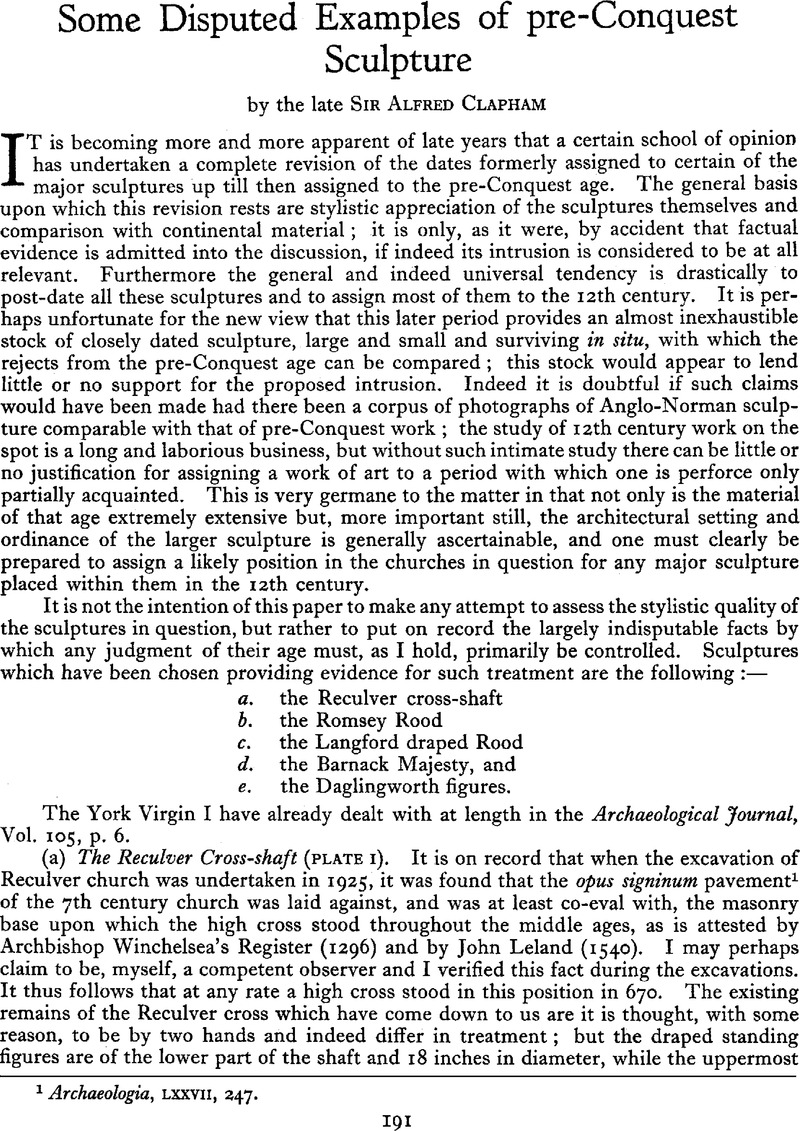Article contents
Some Disputed Examples of pre-Conquest Sculpture
Published online by Cambridge University Press: 02 January 2015
Abstract

Information
- Type
- Research Article
- Information
- Copyright
- Copyright © Antiquity Publications Ltd 1951
References
1 Archaeologia, LXXVII, 247.
2 V.C.H. Hants., IV, 460.
3 S. Casson, ‘Byzantium and Anglo-Saxon Sculpture’. Burl. Mag., LXI, 232.
4 In this connection it may be noted that the Crucifixion on one side of the font at Lenton, Notts, has a Hand of God above the figure, but the iconography and decoration of this font on all four of its sides is so unconnected with English idiom as to make it probable that they are copied from some foreign source. (Rel. and Ill. Arch., N.s. XV (1909), 250 ; J. Romilly Allen, Early Christian Symbolism, pp. 289, 298, 308). It may be noted that the closest parallel to the Lenton Crucifixion is to be found in the rendering of the same subject in the Gerona Apocalyse, finished in 975 (W. Neuss, Die Katalanische Bibelillustration (1922), 63 and taf. 57), where the censing angels, Longinus and the two thieves with attendant angel and demon with the mouth of Hell are represented. Catalan Bibles were apparently current in the Cluniac Order in the 12th century, as Dr Joan Evans informs me, and Lenton Priory was an important house of this Order.
5 E. Mâle, L’art religieux du xiie siècle en France, 78–9.
6 e.g. Reichnau Song of Solomon, end of 10th century, and Gospels of Abbess Uta of Niedermünster, 1002–25.
7 A. Guerra, Storia del Volto Santo di Lucca (1881), 96, 454.
8 M. R. James, ‘Abbey Church of St. Edmund at Bury’, Camb. Antiq. Soc. Com., XXVIII, 139. The possession of two copies of Abbo’s Life of St. Edmund by the Chapter Library at Lucca seems to lend strong support to the statement in the Liber Albus.
9 J. Folch y Torres, Catálogo de la Sección de Arte Románico (Museo de la Ciudadela, Barcelona), 66.
10 See illustration in T. Perkins, Amiens Cathedral, 63.
11 C. de Rémusat, S. Anselme de Cantorbéry (1853), 133.
12 M. H. Longhurst, English Ivories (1926), 22, fig. 8.
13 ‘The Development of Architecture in Gloucestershire to the close of the 12th century’. Bris, and Glos. Arch. Soc. Trans., L (1928), 66.
14 J. Puig y Cadafalch, L’Arquitectura romànica a Catalunya, III (1918) 847 ; Bulletin Mon., LXXXIV (1925), 303.
15 Somerset Arch. & N.H. Soc. Procs., LXXIV, 4. Some of the conventional foliage on the capitals of the tower-arches of late pre-Conquest date at Milborne Port, Somerset, are stated by Dr Allen to be of stucco. Ibid., LXXX, 28 and Plates VIII and IX.
- 1
- Cited by

